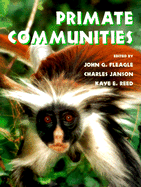Book contents
- Frontmatter
- Contents
- List of contributors
- Preface
- 1 African primate communities: Determinants of structure and threats to survival
- 2 Biomass and use of resources in south and south-east Asian primate communities
- 3 Species coexistence, distribution, and environmental determinants of neotropical primate richness: A community-level zoogeographic analysis
- 4 Primate communities: Madagascar
- 5 Primate diversity
- 6 Phylogenetic and temporal perspectives on primate ecology
- 7 Population density of primates in communities: Differences in community structure
- 8 Body mass, competition and the structure of primate communities
- 9 Convergence and divergence in primate social systems
- 10 Of mice and monkeys: Primates as predictors of mammal community richness
- 11 Comparing communities
- 12 Large-scale patterns of species richness and species range size in anthropoid primates
- 13 The recent evolutionary past of primate communities: Likely environmental impacts during the past three millennia
- 14 Resources and primate community structure
- 15 Effects of subsistence hunting and forest types on the structure of Amazonian primate communities
- 16 Spatial and temporal scales in primate community structure
- 17 Primate communities in Africa: The consequences of long-term evolution or the artifact of recent hunting?
- 18 The future of primate communities: A reflection of the present?
- 19 Concluding remarks
- Systematic index
- Subject index
9 - Convergence and divergence in primate social systems
Published online by Cambridge University Press: 21 August 2009
- Frontmatter
- Contents
- List of contributors
- Preface
- 1 African primate communities: Determinants of structure and threats to survival
- 2 Biomass and use of resources in south and south-east Asian primate communities
- 3 Species coexistence, distribution, and environmental determinants of neotropical primate richness: A community-level zoogeographic analysis
- 4 Primate communities: Madagascar
- 5 Primate diversity
- 6 Phylogenetic and temporal perspectives on primate ecology
- 7 Population density of primates in communities: Differences in community structure
- 8 Body mass, competition and the structure of primate communities
- 9 Convergence and divergence in primate social systems
- 10 Of mice and monkeys: Primates as predictors of mammal community richness
- 11 Comparing communities
- 12 Large-scale patterns of species richness and species range size in anthropoid primates
- 13 The recent evolutionary past of primate communities: Likely environmental impacts during the past three millennia
- 14 Resources and primate community structure
- 15 Effects of subsistence hunting and forest types on the structure of Amazonian primate communities
- 16 Spatial and temporal scales in primate community structure
- 17 Primate communities in Africa: The consequences of long-term evolution or the artifact of recent hunting?
- 18 The future of primate communities: A reflection of the present?
- 19 Concluding remarks
- Systematic index
- Subject index
Summary
INTRODUCTION
Current socio-ecological theory assumes that social systems are the result of adaptations, and thus subject to evolutionary modification by selection (Crook & Gartlan, 1966; Emlen & Oring, 1977; Wrangham, 1987; Ims, 1988). Social systems are not direct targets of selection, however, because they represent the outcome of individual behavioral interactions and strategies (Hinde, 1976). The underlying behavior of individuals towards conspecifics is thought to be largely shaped by ecological factors, such as the distribution of risks and resources in the environment (Wrangham, 1980; van Schaik & van Hooff, 1983; Terborgh & Janson, 1986; van Schaik, 1989), as well as the resulting social boundary conditions (Janson, 1986; van Schaik, 1996). Behavior constitutes, therefore, the crucial interface between individuals and their environment (Terborgh, 1992). Individuals decide at the behavioral level whether they lead a solitary life or form permanent groups, and which group size and composition is optimal under a given set of ecological conditions. An animal's behavioral decisions at this level are therefore a target of selection where convergences among distantly related taxa as a result of similar selection pressures can be expected.
Among mammals, primates exhibit an extraordinary level of diversity in social systems (Smuts et al., 1987), rivaled perhaps only by that found among marsupials and carnivores (Gittleman, 1989; Strahan, 1995). They display all fundamental types of mammalian grouping patterns (Clutton-Brock, 1989) and show a variety of bonding patterns, especially in gregarious taxa (van Schaik, 1989). Thus, the evolution of convergences is not principally constrained by primate-specific traits.
For the purpose of an analysis of convergence in social systems, the living primates can be divided into four major groups with potentially important variation in taxonomic diversity.
- Type
- Chapter
- Information
- Primate Communities , pp. 158 - 170Publisher: Cambridge University PressPrint publication year: 1999
- 22
- Cited by



